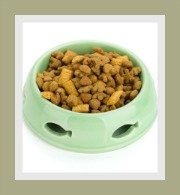Feline Distemper Symptoms
Treatment and Prevention
Feline distemper symptoms are not specific to the disease.
Not all cats that present with diarrhea and vomiting are infected with the parvovirus, i.e. the virus that causes cat distemper.
Distemper is also known as feline infectious enteritis. Enteritis is defined as an inflammation of the lining of the small intestine and may be caused by viruses, bacteria, internal parasites (worms), or due to diet and food related problems.
Having said this, we highly recommend veterinary consultation to either confirm or exclude parvovirus.
Always isolate the cat or kitten until
diagnosis is confirmed. Irrespective of the diagnosis your cat will need
treatment for diarrhea and vomiting to avoid dehydration.
feline distemper symptoms
The incubation period (i.e. the time is takes from exposure to the disease to the appearance of the first signs / symptoms) is between 2 and 10 days.
unborn kitten and kittens
If the mother cat is exposed to the feline
parvovirus in the initial stages of pregnancy, the kittens will die in
utero and either be aborted (still born kittens) or the fetus will
simply be re-absorbed.
If exposure to the feline parvovirus occurs late in the pregnancy or shortly after the birth of the kittens, the kittens will present with central nervous systems symptoms.
Symptoms will include tremors or an
uncoordinated gait - in other words, the kittens will not be able to
walk properly, their heads may bob up and down.
Kittens born to parvovirus infected mothers may be born blind due to infection of the optic nerve or retina.
In kittens or immune-compromised cats, the first sign of illness may be sudden death, which is often misdiagnosed as 'fading kitten syndrome'.
adult cats
In some cats, feline panleukopenia symptoms may be absent or be so mild that they go unnoticed. The cat may in fact recover and develop lifetime immunity to the disease.
In the first week after exposure to the virus, you can expect to see the following:
- lack of appetite
- general lethargy and fever
The cat may survive this stage, but the disease quickly progresses from here. As soon as these feline distemper symptoms are noted, veterinary advice must be sought:
- fever with a temperature of 40 °C or 104 ° F,
- vomiting froth which contains bile
- the cat appears thirsty and may even sit at its water bowl and literally drool, but will not drink
- diarrhea which is characterized by an offensive-smelling, watery stool containing blood and mucus
- cat's abdomen will be very tender and bloated due to an inflamed gastrointestinal tract
The combination of diarrhea, vomiting and a refusal to drink or eat soon leads to severe dehydration.
Sadly, at
this stage, there is a high mortality. The cat or kitten will become
hypothermic (temperature very low) and may go into shock and die.
treatment of feline distemper
There is no cure or specific treatment for this disease.
Treatment is based on managing the feline distemper symptoms. The veterinarian will decide on the best course of treatment for the sick cat.
The treatment regime may include one or all of the below mentioned:
- An intravenous drip will provide intravenous fluids containing
glucose and saline to rehydrate, replace electrolytes and it also provides a vehicle to
administer other drugs.
- Blood and or plasma transfusions may be considered to treat hypotension (low blood pressure) and possible anemia.
- Drugs to reduce the diarrhea and vomiting i.e. anti-emetics and anti-diarrhoeals.
- Broad spectrum antibiotics to eliminate any secondary infections.
- All food and oral fluids will be withheld until such time as the inflamed gastrointestinal tract has had time to recover.
- Nursing treatment will involve keeping the cat or kitten clean, dry and comfortable.
- The cat must be nursed in total isolation from other
hospitalized pets.
- Barrier nursing will be carried out to prevent
contamination and to avoid the spread of infection.
- Nursing will be long and intensive (2 - 4 weeks)
The good news is that if the cat or kitten survives this disease, they will develop natural immunity to the disease.
Vaccination is
certainly a better and cheaper alternative!
feline distemper prevention
Prevention is better than cure!
The Feline Panleukopenia Virus vaccine is considered a core vaccine.
It is a highly effective vaccine, so do consult with your veterinarian with regards to the early administration of this vaccine to prevent your cat from contracting this deadly disease.
Feline distemper is more prevalent in kittens, but mature cats and even indoor cats are at risk of contracting the feline parvovirus.
Responsible cat owners should ensure that their cats are given annual
booster shots as recommended by their vet.
disinfecting the home | cattery
The parvovirus is a hardy virus which survives in the environment for years.
It is critically important that multi-cat homes, catteries and shelters be kept scrupulously clean and be thoroughly disinfected especially after an 'outbreak' of feline distemper.
New cats or kittens should not be introduced into the home (or cattery) for at least 6 months after the presence of a FPV infected cat or kitten.
All infected cats and kittens must be isolated.
Staff caring for cats presenting with feline distemper symptoms (or cats that are infected with this deadly disease), need to have their own overalls and boots.
These items need to be thoroughly disinfected after use.
Hand washing is essential.
If possible employ separate staff to care for infected cats.
Infected areas need to washed down with a pressure hose at least once a day and then disinfected with an appropriate commercially available disinfectant or bleach and formaldehyde
All infected bedding, bowls, toys and furniture needs to be washed and disinfected.
Top of Feline Distemper Symptoms
Return to Feline Distemper
search our site
please like us
share our site
recommend on google
favorite pages





